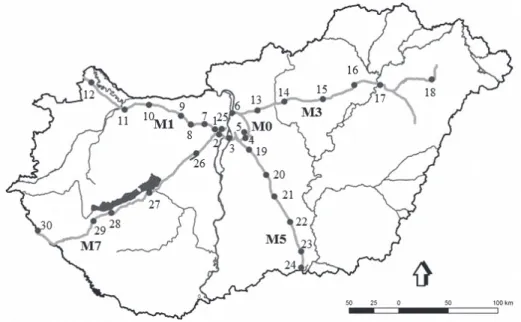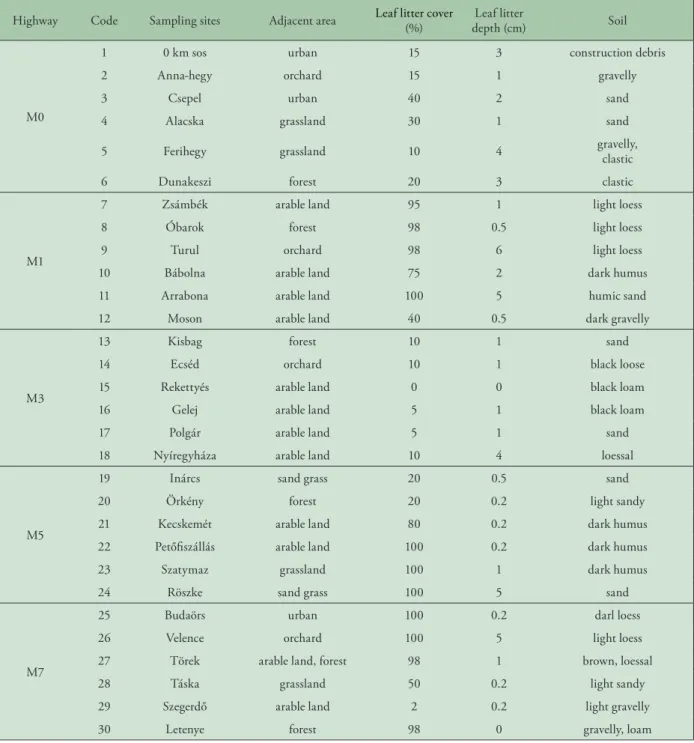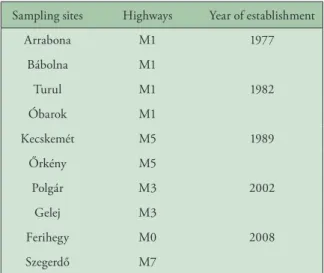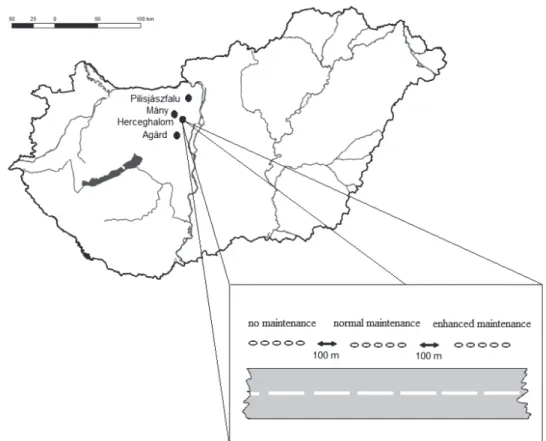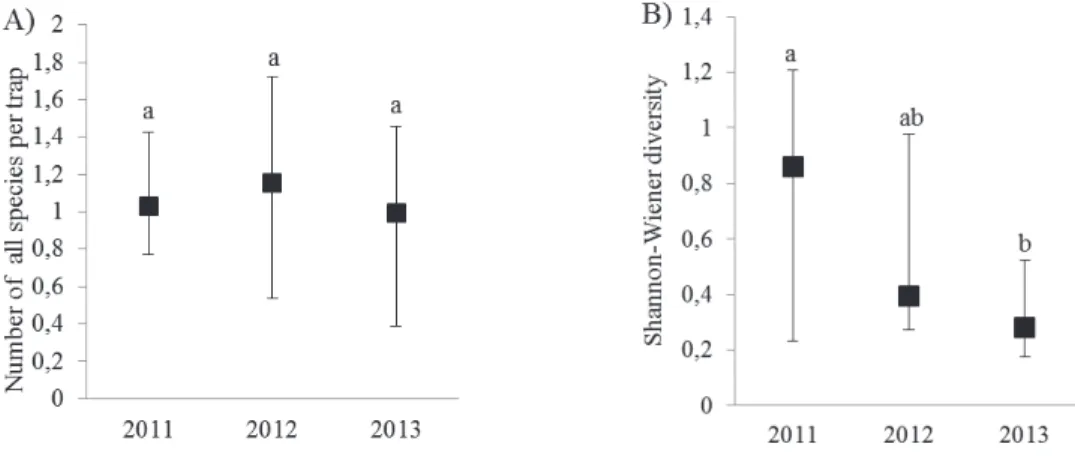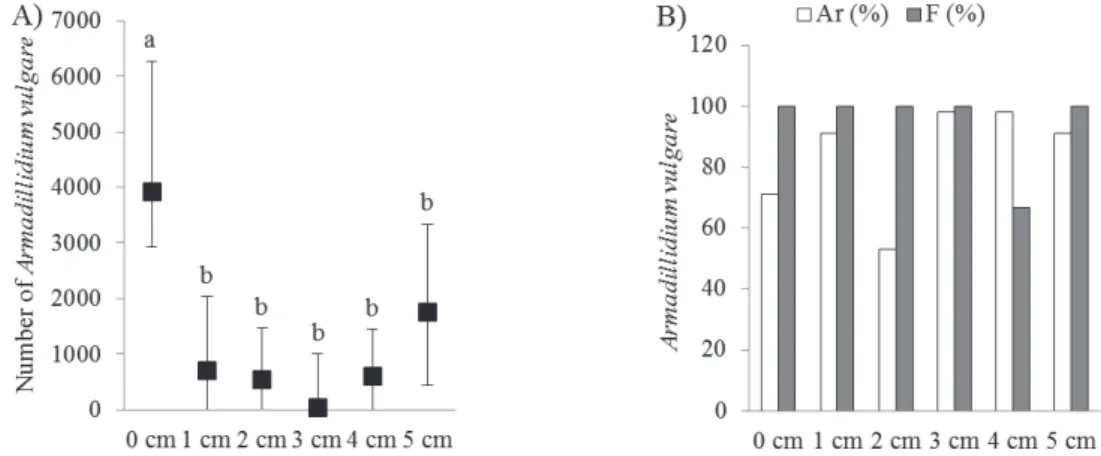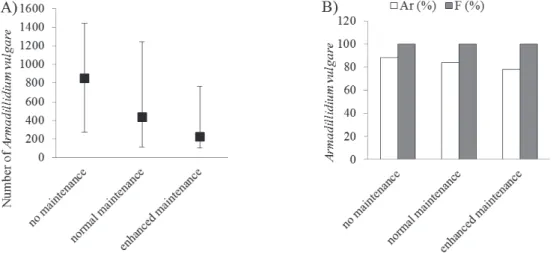original research article
VOL. 120, No 2–3, 91–103, 2018 CODEN PDBIAD
DOI: 10.18054/pb.v120i2-3.5632 ISSN 0031-5362
Invasive occurrence and abundance changes of Armadillidium vulgare (Latreille, 1804) in Hungarian roadside verges
Abstract
Background and purpose: The impact of invasive species in ecosystems is an important problem worldwide and the spreading of invader species are affected exceedingly by linear infrastructure. Primarily the aim of our in- vestigation was to studied how the invasion of the species impacts the isopod diversity of roadside verges. Secondly, we determined what attributes of li- near infrastructure affect on mass occurrence by the species.
Materials and methods: Double-glass pitfall traps were established 30 localities along highways and 4 localities along main roads in Hungary between 2011 and 2016. To studied what attributes of roads affect the abundance of A. vulgare we considered seasons, adjacent areas, road edge proximity, leaf-litter depth, the age of highway, vegetation type and mowing.
Results: We collected a total of 18 isopod species. The A. vulgare was the most abundant and frequently encountered species in both road types, whi- ch represented 89% of the total isopod catches. The high abundance of the species negatively correlated with isopod diversity. The invasive nature of this species is promoted by summer season, the proximity of arable fields, intermediate distance from the road, leaf-litter at a depth of 0 cm and the young age of highways. On mainroad verges the highest abundance was in the non-mown sections of the arid grassland sites.
Conclusions: Our results suggest that this species is likely to adversely impact ecosystem function of roadside verges in Hungary. Different land use, water supply, surrounding landscapes, habitat structure, vegetation, biogeographical context and human activities along road verges influence the invasiveness of A. vulgare.
INTRODUCTION
R
oadside verges function as prime habitats for several native, exotic and invasive animal and plant species (1, 2, 3, 4). Roads provide not only refuges for protected and endangered species in agriculturally- dominated landscapes but also function as invasion pathways for arthro- pods (5, 6, 7, 8). However, roads also exert significant negative effects on communities, wildlife populations and ecosystems of surrounding habitats (9). The presence of roads and traffic may alter the chemical environment, modify animal behaviourand provide dispersal routes for species (1). Linear infrastructure, vehicles and roadside verges may be important elements in determining the spatial spread of an organism’s distribution (6, 10). In heavily disturbed and modified habitats such as highways, invasive species have a chance to adapt and spread alongDIÁNA VONA-TÚRI1 TÜNDE SZMATONA-TÚRI2 BLANKA GÁL3,4 ANDRÁS WEIPERTH5 BALÁZS KISS6
1 Eötvös József Reformed Education Center, H-3360 Heves, 29. Dobó street, Hungary, E-mail: turidiana79@gmail.com, ORCID: 0000-0003-3910-8898
2 Forestry, Agricultural and Game Management Training School and Student Hostel of Mátra, H-3232 Mátrafüred, 11. Erdész street, Hungary, E-mail: turitunde79@gmail.com,
ORCID: 0000-0002-8314-3183
3 MTA Centre for Ecological Research, Balaton Limnological Institute, Klebelsberg Kuno steet 3.
Tihany 8237, Hungary
4 Doctoral School of Environmental Sciences, Eötvös Loránd University, H-1117 Budapest, 1/C Pázmány Péter promenade, Hungary, E-mail: galblankaa@gmail.com, ORCID: 0000-0001-8513-3010
5 Centre for Ecological Research, Hungarian Academy of Sciences, Danube Research Institute, H-1113 Budapest, 29. Karolina road, Hungary, E-mail: weiperth.andras@okologia.mta.hu, ORCID: 0000-0001-7824-68853
6 Center of Agricutural Research, Hungarian Academy of Sciences. Plant Protection Institute
H-1022 Budapest, 15. Herman Ottó road, Hungary, E-mail: kiss.balazs@agrar.mta.hu,
ORCID:0000-0003-2511-9094 Correspondence:
Diána Vona-Túri
E-mail: turidiana79@gmail.com
Key words: vegetation; disturbance, road-edge proximity; leaf-litter; highway operation time; mowing
Received September 17, 2017.
Revised July 02, 2018.
Accepted April 30, 2019.
2) We compared the abundance of A. vulgare based on seasons in highway verges. We assumed that the maxi- mum number of individuals will peak abundance in au- tumn because of its semelpar reproduction (18).
3) We studied the effect of adjacent areas of highway verges on A. vulgare abundance. Our hypothesis was that this species prefers disturbed open habitats compared to other isopod species which prefer wet forested habitats, because of the species is an indicator of anthropogenic impacts.
4) We analysed the effects of road edge proximity on highways and we expected that the highest abundance of A. vulgare would occur at an intermediate distance from the road, because of the intermediate disturbance hypothesis.
5) We compared the abundance of A. vulgare in high- way sampling sites based on leaf-litter depth between 0–5 cm intervals. We hypothesised that the species abundance would increase with leaf-litter depth, because of the spe- cies contribution to decomposition processes.
6) We assessed differences between sampling sites based on highway age. We hypothesised that there would be a decrease in the abundance of the species from the oldest sites to the youngest sites, because of the invasive nature of this species.
7) In main roads we examined the effect of the main Hungarian vegetation types and we expected the highest abundance of A. vulgare in open habitats, such as grass- lands.
8) Finally, we analysed the effect of mowing on the abundance of A. vulgare on main roads. Our hypothesis was that the mowing would negatively affect the number of individuals.
roadsides by the green corridor effect (11). The distribu- tion of other species is reduced or becomes isolated to facilitate the expeditious spread of invasive species (12).
However, not all new species can adapt and spread in the new area after entering and become invasive, as the „tens rules” by Williamson & Fitter (13) illustrates well. In the new habitats, 10% of imported species can escape to the wild, 10% of occasionally colonizing species become naturalized, and only 10% of naturalized species become invasive. Over recent decades the spread of invasive spe- cies is related to climate change and the ever-increasing development of international commerce (14). The appear- ance of a new invasive species into an ecosystem often does not result in an immediate impact, furthermore, in many cases, it is difficult to estimate which species are essential to ecosystem functioning and which are redun- dant (15). The presence of invasive species in ecosystems is a remarkable problem worldwide because they have an impact on the structure and function of ecosystems, and biodiversity and the loss of habitats, and invader species can cause serious environmental, economic or social dam- age (16). Clavero & García-Berthou (17) showed that overgrowth of invasive species contributed to 54% of ex- tinction of animal species.
Firstly, the main objectives of this study were to inves- tigate the invasive occurrence of A. vulgare along Hungar- ian highways, and we studied how the invasion of the species impacts the isopod diversity of highway verges.
1) We hypothesised that A. vulgare has a negative effect on the diversity of the isopod communities because of the species invasiveness. Secondly, we explored what attri- butes of roads (seasons, adjacent areas, road edge proxim- ity, leaf-litter depth, highway age, vegetation and mow- ing) affect the abundance of A. vulgare.
Figure 1. Map of highways and the sampling sites. The code of sampling sites can be found in Table 1
MATERIAL AND METHODS
Study sites and sampling procedure Highways
Data collection was done along 5 Hungarian highways (M0, M1, M3, M5, M7) (Figure 1). Highway M0 is consi- dered to be the main road but it is managed as a highway in Hungary, because the traffic intensity on the main road is the same as that of highways. Thirty sampling points were selected in the highway verges that were located
among neighbouring habitats with different type of vege- tation and various level of disturbance. Along each hig- hway we selected 6-6 sampling points (Table 1) where a total of 180 double-glass pitfall traps made of 3 dl plastic cups filled with a 65% aqueous solution of ethylene glycol were established. Sampling sites were selected next to the lay-bys along highway where isopods were sampled using 6-6 pitfall traps at each site and the distance between traps was 5 m. The traps were deployed three times (spring, summer, autumn) over a three-week period each year. On highways, we studied the effects of seasons, ad-
Table 1. Characterization of sampling sites along highway
Highway Code Sampling sites Adjacent area Leaf litter cover
(%) Leaf litter
depth (cm) Soil
M0
1 0 km sos urban 15 3 construction debris
2 Anna-hegy orchard 15 1 gravelly
3 Csepel urban 40 2 sand
4 Alacska grassland 30 1 sand
5 Ferihegy grassland 10 4 gravelly,
clastic
6 Dunakeszi forest 20 3 clastic
M1
7 Zsámbék arable land 95 1 light loess
8 Óbarok forest 98 0.5 light loess
9 Turul orchard 98 6 light loess
10 Bábolna arable land 75 2 dark humus
11 Arrabona arable land 100 5 humic sand
12 Moson arable land 40 0.5 dark gravelly
M3
13 Kisbag forest 10 1 sand
14 Ecséd orchard 10 1 black loose
15 Rekettyés arable land 0 0 black loam
16 Gelej arable land 5 1 black loam
17 Polgár arable land 5 1 sand
18 Nyíregyháza arable land 10 4 loessal
M5
19 Inárcs sand grass 20 0.5 sand
20 Örkény forest 20 0.2 light sandy
21 Kecskemét arable land 80 0.2 dark humus
22 Petőfiszállás arable land 100 0.2 dark humus
23 Szatymaz grassland 100 1 dark humus
24 Röszke sand grass 100 5 sand
M7
25 Budaörs urban 100 0.2 darl loess
26 Velence orchard 100 5 light loess
27 Törek arable land, forest 98 1 brown, loessal
28 Táska grassland 50 0.2 light sandy
29 Szegerdő arable land 2 0.2 light gravelly
30 Letenye forest 98 0 gravelly, loam
jacent areas, road edge proximity, leaf litter depth and the age of highways on the abundance of A. vulgare. Selection of sampling sites and coordination of sampling methods were occurred by the Center of Agricultural Research, Hungarian Academy of Sciences, Plant Protection Insti- tute. When we analysed the effect of different factors on the abundance of A. vulgare, we did not consider the data of all 30 sampling sites except for annual and seasonal examination. To examine the effect of adjacent areas and
road edge proximity, we selected 15 sampling sites (see Table 2). To assess the effect of leaf litter depth, we consi- dered 12 sampling sites (see Table 3). To examine the effect of age of highways, we selected 10 sampling sites (see Table 4).
Main roads
Along Hungarian main roads data was collected at four sampling sites representing the main types of verge habitats between 2014–2016 (Figure 2). Verge types were categorised based on the vegetation type of neighboring habitats. Sampling area Pilisjászfalu (Road No. 10) consisted of arid grassland with some small bushes. Mány (Road No. 1) was situated in the lowlands and hilly land- scapes of Hungary, and was bordered by 2 roads running through agricultural land. Herceghalom (Road No.1) was situated next to a forest. Agárd (Road No. 7) crosses a wetland area in the west section of Lake Velence. All localities included three sections representing (1) no ma- intenance (non mown) (2) normal maintenance (mown once a year) and (3) enhanced maintenance (mown twice or three times a year). The distance between 2 sections was 100 m. In each section five pitfall traps were estab- lished 5 meters apart, and they were located 1,5 meters from the roads. Double glass pitfall traps filled with ethy- lene glycol were used which were left in the fields for three weeks and three times a year in different seasons (spring, summer and autumn). We collected samples after first mowing in between May and June. After the second mowing the field experiment was repeated twice in Au- gust and September. Trapped specimens were preserved in 75 percent alcohol. Sampling methods made it possib- le to study the effects of vegetation type and mowing on abundance of A. vulgare. Selection of sampling sites and coordination of sampling methods were occured by the Centre for Ecological Research, Hungarian Academy of Sciences, Danube Research Institute.
Table 2. Sampling sites along highways used to examine the effect of adjacent areas and road edge proximity
Types of
adjacent areas Highway Sampling
site Distance from the road (~)
Natural and semi-natural Grasslands
M5 Röszke 20 m
M0 Ferihegy 40 m
M7 Táska 90 m
Forest
M5 Örkény 20 m
M3 Kisbag 40 m
M1 Óbarok 90 m
Disturbed
Urban
M0 0 km 20 m
M7 Budaörs 40 m
M0 Csepel 90 m
Orchard
M3 Ecséd 20 m
M1 Turul 40 m
M7 Velence 90 m
Arable land
M7 Szegerdő 20 m
M3 Polgár 40 m
M5 Kecskemét 90 m
Table 3. Sampling sites along highways used to examine the effect of leaf-litter depth
Highways Sampling sites Leaf litter depth (cm)
M7 Letenye 0
M3 Rekettyés
M0 Alacska 1
M3 Gelej
M0 Csepel 2
M1 Bábolna
M0 Dunakeszi 3
M0 0 km
M0 Ferihegy 4
M3 Nyíregyháza
M5 Röszke 5
M1 Arrabona
Table 4. Sampling sites along highways used to examine the effect of age of highway
Sampling sites Highways Year of establishment
Arrabona M1 1977
Bábolna M1
Turul M1 1982
Óbarok M1
Kecskemét M5 1989
Őrkény M5
Polgár M3 2002
Gelej M3
Ferihegy M0 2008
Szegerdő M7
Data analysis
We used the PAST Paleontological Statistic suite for data analysis (19). Besides a number of individuals, we computed Shannon-Wiener diversity in order to analyse the invasive patterns of A. vulgare. The Shannon-Wiener index is more sensitive to the frequency of rare species (20, 21, 22). Species with the highest abundance have the greatest influence on the Simpson’s index (20, 21, 22). The characterization of the A. vulgare population was based on relative abundance (Ar) and frequency (F). The years were the replications, except for the case of the annual population dynamics, when sampling dates were the rep- lications. One-Way ANOVA was applied to assess the differences between the number of individuals of A. vul- gare in relation to years, seasons, adjacent areas, road edge proximity, leaf-litter depth and highway age. We used the keys of Hopkin (23), Schmidt (24), and Farkas & Vilisics (25) for identification of isopod specimens. Species’ names were applied according to Schmalfuss (26).
RESULT γ-diversity
Along main roads, we collected 6 isopod species and on highway verges 18 species. During our study A. vulgare was the most abundant isopod species (highways: Ar
=89% of a total number of individuals collected, main roads: Ar = 89%) and frequent species (highways: F = 94%, main roads: F = 100%). A total of 52361 specimens of A. vulgare were collected along roads, composed of 45626 individuals on highway verges and 6735 individu- als on main road verges.
Highways
We examined the annual population dynamics along highways and we found no significant differences (p=0.416) in abundance of A. vulgare. The number of A. vulgare, the relative abundance and the frequency increased with years (Figure 3). Simultaneously, the values of Shannon-Wiener diversity of isopods along highways decreased with years, beacause it was significantly lower (p= 0.049) in 2013 compared to 2011 (Figure 4).
Significant differences were no found between number of A. vulgare (p=0.287) in relation to season. The number of the species was the highest in summer and the lowest was in autumn. The highest relative abundance and fre- quency of the species also were in summer, while the low- est was in autumn (Figure 5).
We found statistically significant differences in num- ber of A. vulgare (p=0.013) in relation to adjacent areas of highways. Abundance of A. vulgare was significantly higher next to arable lands compared to verges next to
Figure 2. Sampling sites and treatment along main roads
forests, urban areas and orchards. The relative abundance of the species was lowest next to urban areas than the other verges, while the frequency of the species was 100%
in each verges (Figure 6).
Significant differences were found between number of the species (p=0.045) in relation to road edge proximity.
The number of A. vulgare was significantly higher at 40 m from the road than at 20 m from the road. The relative
Figure 3. Annual population dynamics of abundance (A), and relative abundance and frequency (B) of A. vulgare (average ± S.E.).
Figure 4. Annual population dynamics of species richness (A) and Shannon-Wiener diversity (B) of isopod assemblages in highway verges (average
± S.E.). Different letters indicate significant (p<0.05) differences (one-way ANOVA)
Figure 5. Abundance (A) and relative abundance and frequency (B) of A. vulgare in highway verges in relation to season (average ± S.E.).
Figure 6. Abundance (A) and relative abundance and frequency (B) of A. vulgare in highway verges in relation to adjacent areas (average ± S.E.). Different letters indicate significant (p<0.05) differences (one-way ANOVA)
Figure 7. Abundance (N) and relative abundance and frequency (B) of A. vulgare in highway verges located at different distances (20 m, 40 m and 90 m) from roads (average ± S.E.). Different letters indicate significant (p<0.05) differences (one-way ANOVA)
Figure 8. Abundance (N) and relative abundance and frequency (B) of A. vulgare in highway verges relative to leaf-litter depth in the verges that were examined (average ± S.E.). Different letters indicate significant (p<0.05) differences (one-way ANOVA)
abundance of A. vulgare was lowest at 20 m from the road and the frequency of the species was equal in each dis- tance from the road (Figure 7).
There were significant differences (p=0.00016) in abundance of A. vulgare in relation to leaf-litter depth.
The number of A. vulgare was significantly highest in sam-
pling sites at 0 cm leaf-litter depth, and it was signifi- cantly lowest in sampling sites with 3 cm leaf-litter depth compared to sampling sites with 5 cm leaf-litter depth.
The relative abundance of A. vulgare was lowest in sam- pling sites at 2 cm leaf-litter depth and the frequency of
the species was equal in each verges except for the sites at 4 cm leaf-litter depth (Figure 8).
We observed statistically significant differences in number of A. vulgare (p=0.010) in relation to years when highway have been finished. The abundance of the species
Figure 9. Abundance (N) and relative abundance and frequency (B) of A. vulgare in highway verges relative to the year when highway have been finished (average ± S.E.). Different letters indicate significant (p<0.05) differences (one-way ANOVA)
Figure 11. Abundance (N) and relative abundance and frequency (B) of A. vulgare in mainroad verges relative to mowing intensity (average ± S.E.).
Figure 10. Abundance (N) and relative abundance and frequency (B) of A. vulgare in mainroad verges relative to the vegetation type (average
± S.E.).
was significantly highest in verges that were established in 2002 compared to other verges. The relative abundance of A. vulgare increased from old verges to young verges and the frequency of the species was equal in each verge types (Figure 9).
Main roads
Statistically significant differences were no found be- tween number of A. vulgare (p=0.886) in relation to veg- etation type of main roads. The highest number of relative abundance of A. vulgare were in arid grassland and in wetland, while the lowest was in the forested verges (Fig- ure 10).
Finally, along main roads, significant differences were no found between number of A. vulgare (p=0.370) in re- lation to mowing intensity. The mowing negatively af- fected the number of individuals and the relative abun- dance of A. vulgare. The highest number of specimens and relative abundance of the species were recorded in the no maintenance sections, whereas the lowest number was in enhanced maintenance sections (Figure 11).
DISCUSSION Highways
The isopod fauna of roadside verges are not typically the focus of zoological research, and there are few pub- lished studies on this taxon. We are the first researchers to examine the isopod fauna along roads in Hungary. The holomediterranean A. vulgare, which is a typical indicator of anthropogenic impacts (27), probably originated in the eastern mediterranean region (28). In Hungary, A. vulgare was initially discovered by Csiki Endre in 1926 in Buda- pest, Bodajk and Pápa (29). This widely distributed spe- cies can be found in most parts of the world, and is as- sociated with high human activity and has a broad ecological tolerance (28). This life history may explain why this species can colonise disturbed habitats such as roadsides. The high abundance of A. vulgare reflects the environmental tolerance and invasive nature of this spe- cies. A. vulgare is one of the most common species of isopod in Hungary (25). The abundance of A. vulgare was observed to be similar to other habitats in Hungary. Our results compare well to Szlávec (30) in Hortobágy Na- tional Park, Farkas (31, 32) in Somogy county, in Ba- ranya county (33) and in Tolna county (34) A. vulgare was one of the most frequent and abundant species in the areas examined. Hornung et al. (12, 35) studied isopods in Budapest and other cities and observed that A. vulgare was the widest spread and common species.
The high number of traps we deployed along highways made it possible to assess the relationship between isopod diversity and the high abundance of A. vulgare. Our results support our hypothesis that A. vulgare has a nega- tive effect on the diversity of the isopod communities.
Davis (36) examined isopods in a dune grassland and observed that A. vulgare showed a sudden increase in ag- gregation in 1968 and 1973. Similarly, by examining the annual population dynamics, we found that the increa- sing abundance of A. vulgare was related to the decreasing isopod diversity on highways. Horváth et al. (37), Magu- ra et al. (38) and Bogyó et al. (39) concluded that while the populations of species that are successful adapters increase, the distribution and occurrence of less-adaptive species decreases.
Our results based on seasonality do not support the hypothesis that the highest abundance of A. vulgare is in autumn. The high abundance of species in summer on highway verges might be explained by the high reproduc- tive potential (40), excellent adaptation ability and dehydration tolerance (41). In isopods, the main mecha- nism for water loss is evaporation from the respiratory organs and the body surface (42). Isopods differ expressly in their ability to tolerate dry conditions (43). Arid-tole- rant-species have a complex structural respiratory system and thick cuticle (44). Among the examined Hungarian Armadillidium species (A. zenkeri, A. nasatum, A. versi- color, A. vulgare), A. vulgare has the thickest cuticle and an extremely structured respiratory system (41), and is able to take up 94% of its normal oxygen requirement in dry air with a dry integument (45). According to many published studies, the long-day photoperiods (46) and the warm temperatures (47) stimulate the reproduction and the growth of the offspring (48) of A. vulgare. This speci- es produced larger offspring when the food supply of fe- males is reduced, for example, in summer when food availability and quality is low (49). Moreover, females may not produce offspring until the third year, which will be smaller in size (48).
The larger difference between the fragmented and the adjacent land in vegetation structure is expected to lead to microclimate differences and hence, a greater edge effect (50). To test our hypotheses we compared highway sampling sites based on adjacent areas. Our results clearly demonstrate that sites near arable fields proved to be more advantageous to A. vulgare. Human activity stresses soil communities due to heavy fertilizer use, frequent biocide treatment and export of nutrient and organic matter (51).
Conversely, many studies show that the margins of arab- le fields rapidly produce biodiversity benefits for the soil macrofauna (52, 53). The high abundance of A. vulgare recorded near arable fields reflects the species’ ability to adapt to disturbed and open habitats. Wolters & Ek- schmitt (51) showed that although the abundance and diversity of isopods in arable lands is very low, marginal habitats adjacent to arable lands have the highest abundance.
Our data showed that A. vulgare abundance was hig- hest at intermediate (40 m) distances from the road, whi- ch supported our hypothesis. Roadside verges have a spe- cific flora and fauna, contained within an ecotone (54).
Delgado et al. (55) showed that the highest frequency of litter invertebrate species occurred close to a road (10 and 20 m from the edge).
We expected that the highest number of A. vulgare would be observed in sampling sites that had the thickest leaf-litter, but our result does not support this hypothesis.
It is known that isopods are responsible for most of the decomposition of organic matter, mostly leaf litter decom- position (56). The leaf-litter and its microorganisms serve as food sources for isopods. Moreover, the surfaces of plant residues have much more active microbial biomass than in the soil (57). However, we found that the 0 cm thick leaf-litter provided the most suitable habitat for A.
vulgare. Thick leaf-litter has increased CO2 levels, which has a negative effect on the fertility of isopods (58). Pan- lasigui (27) showed that A. vulgare displays a preference for leaf-litter with a water content of 0.39 compared to litter with a water content 0.53.
Because the regeneration of natural vegetation going on 30–40 years, we expected the highest abundance on the oldest highway sampling site, but our hypothesis was not supported by this result. Several studies show that many invader plant and animal species’colonies have ex- panded along roads where the age of roads has an impact on the diversity and abundance of organisms (7, 59, 60, 61, 62, 63). Similarly, we found an increase in the relative abundance of A. vulgare that probably reflected the inva- sive patterns of the species. Along with Hungarian hig- hways, Fetykó (64) observed only a slight increase in the number of scale insects in the old sampling sites, but Len- gyel et al. (63) provided evidence for a growing population of spotted wing drosophila at such sites.
Main roads
The highest abundance of A. vulgare was in arid grass- lands, which confirmed our original hypothesis. We conclude that A. vulgare is a typical and common species of drier areas (65, 45, 66). Miller & Cameron (67) showed that survivorship of A. vulgare in Texas was highest in grassland areas. Roadside verges of Hungary typically consist of grassy vegetation, habitats that may be facilita- ting the invasion and spread of A. vulgare. The road stret- ches examined are located in lowland areas that bypass the mountain regions, which may also explain the high biomass of A. vulgare on roadside verges. According to our data, abundance of A. vulgare was highest in grassy verges of main roads compared to other verge types. According to Farkas & Vilisics (25), this cosmopolitan species has a ubiquitous distribution in Hungary, except for protected hardwood forests. Our findings concur with Farkas &
Vilisics (25) in addition, the relative abundance of A. vul- gare was lowest in the forested verges of main roads and highway verges near forests. Few studies have examined isopod communities in Hungarian mountainous areas.
In the North-Vértes Mountains, and in Hungarian Nort-
hern Mountains, Kontschán (68, 69) observed that A.
vulgare was not common. In Mátra Mountains, Vo- na-Túri & Szmatona-Túri (70) found that the species was not dominant. Vilisics & Hornung (71) examined many regions in Hungary: Great Plains, Little Plains, Western Hungary, Transdanubian Hills, Transdanubian Moun- tain Range, Northern Mountain Range, Aggtelek Natio- nal Park and Budapest. According to their studies A.
vulgare dominated the isopod communities, but the spe- cies was not detected in the Northern Mountain Range.
Accordingly, the biogeographical context and habitat structure are likely impacting the spread of A. vulgare along roads.
Mowing has a positive effect on floral diversity which contributes to a diverse habitat structure and increasing animal and plant species richness (72, 73, 74). Responses of isopods to mowing are not well known but studies about other soil-dwelling arthropods suggest that grass- land management can alter soil humidity, vegetation structure and lighting conditions (75), factors that likely influence isopod communities. Our result concerning the high abundance on non-mowing sections confirms our hypothesis. Although A. vulgare adapt well to dry condi- tions and disturbance, mowing has a negative effect on the species’ abundance.
Conclusion
Our results demonstrate that the terrestrial isopod A.
vulgare was common and widespread in Hungarian road- side verges. The ability of this species to successfully co- lonize open vegetation and its tolerance of dry conditions can be attributed mostly to its anatomical features. Besi- des roads and traffic, biogeographical context, different land use, water supply, surrounding landscapes, habitat structure and vegetation significantly influence the abundance of A. vulgare. The increasing abundance of A.
vulgare in Hungary is related to the decreasing species diversity of other isopods on highways. Consequently, this invasive species is likely to be a strong determinant of invertebrate community composition and as such may influence ecosystem function along roadside verges in Hungary.
ACKNOWLEDGEMENTS
We thank Ferenc Kádár for help in the sampling ani- mals. We thank Eszter Illyés (deceased) and Csaba Mol- nár for their assistance with the botanical survey. The project was funded by k83829 OTKA. We thank the National Road Authority and the field experts for bo- tanical and zoological reference sampling and for measur- ing the biotic and abiotic environmental parameters of each sampling area. The project was funded by CEDR- Harmony. We thank Andrew Hamer (University of Mel- bourne) for proofreading the manuscript.
REFERENCES
1. TROMBULAK S C, FRISSELL C 2000 A. Review of ecological effects of roads on terrestrial and aquatic communities. Conserv.
Biol. 14: 18-30.
https://doi.org/10.1046/j.1523-1739.2000.99084.x
2. HANSEN M J, CLEVENGER A P 2005 The influence of distur- bance and habitat on the presence of non-native plant species along transport corridors. Biol. Conserv. 125 (2): 249–259.
https://doi.org/10.1016/j.biocon.2005.03.024
3. PAUCHARD A, ALABACK P B 2006 Edge type defines alien plant species invasions along Pinus contorta burned, highway and clearcut forest edges. For. Ecol. Manage.223: 327–335.
https://doi.org/10.1016/j.foreco.2005.11.020
4. KNAPP M, SASKA P, KNAPPOVÁ J, VONIČKA P, MORAVEC P, KURKA A, ANDEL P 2013 The habitat-specific effects of high- way proximity on ground-dwelling arthropods: implications for biodiversity conservation. Biol. Conserv. 164: 22–29.
https://doi.org/10.1016/j.biocon.2013.04.012
5. TIKKA P M, HOGMANDER H, KOSKI P S 2001 Road and railway verges serve as dispersal corridors for grassland plants.
Landsc. Ecol. 16 (7): 659–666.
https://doi.org/10.1023/A:1013120529382
6. HAWBAKER T J, RADELOFF V C, CLAYTON M K, HAM- MER R B, GONZALES-ABRAHAM C E 2006 Road develop- ment, housing growth and landscape fragmentation in northern Wisconsin: 1937-1999. Ecol. Appl. 16: 1222-1237.
https://doi.org/10.1890/1051-0761(2006)016[1222:RDHGAL]2.0.
CO;2
7. BRISSON J, DE BLOIS S, LAVOIE C 2010 Roadside as invasion pathway for common reed (Phragmites australis). Inv. Plant. Sci.
Manag. 3 (4): 506–514. https://doi.org/10.1614/IPSM-09-050.1 8. HOLDEREGGER R, DI GIULIO M 2010 The genetic effects of
roads: a review of empirical evidence. Basic Appl. Ecol. 11 (6):
522–531. https://doi.org/10.1016/j.baae.2010.06.006
9. VAN DER REE R, JAEGER J A G, VAN DER GRIFT E A, CLEVENGER A P 2011 Effects of roads and traffic on wildlife populations and landscape function: road ecology is moving to- wards larger scales. Ecol. Soc. 16 (1): 48.
https://doi.org/10.5751/ES-03982-160148
10. MARTINEZ J J I, WOOL D 2006 Sampling bias in roadsides:
the case of galling aphids on Pistacia trees. Biodivers. Conserv.
1–13. https://doi.org/10.1007/s10531-004-6685-2
11. ALARUIKKA D M, KOTZE D J, MATVEINEN K, NIEMELÄ J 2002 Carabid and spider assemblages along an urban to rural gradient in Southern Finland. J. Insect Conserv. 6: 195–206.
https://doi.org/10.1023/A:1024432830064
12. HORNUNG E, VILISICS F, SZLÁVECZ K 2007 Hazai szárazföldi ászkarák fajok (Isopoda, Oniscidea) tipizálása két na- gyváros, Budapest és Baltimore (ÉK Amerika) összehasonlításának példájával (Standardization of Hungarian terrestrial isopods com- paring two big cities, Budapest and Baltimore (North America)).
Termvéd Közl.13: 47–58
13. WILLIAMSON M H, FITTER A 1996 The characters of success- ful invaders. Biol. Conserv. 78(1-2): 163-170.
https://doi.org/10.1016/0006-3207(96)00025-0
14. THUILLER W, RICHARDSON D M, MIDGLEY G F 2007 Will Climate Change Promote Alien Plant Invasions? In: Nentwig W (ed.) Biological Invasions. (Ecological Studies Vol. 193).Spring- er-Verlag, Berlin p. 197–211.
https://doi.org/10.1007/978-3-540-36920-2_12
15. LOWE S, BROWNE M, BOUDJELAS S, DE POORTER M 2000 100 of the World’s Worst Invasive Alien Species. A selection from the Global Invasive Species Database. Published by The In- vasive Species Specialist Group (ISSG) a specialist group of the
Species Survival Commission (SSC) of the World Conservation Union (IUCN) p. 12.
16. CHARLES H, DUKES J S 2007 Impacts of Invasive Species on Ecosystem Services. In: Nentwig W. editor. Biological invasions (Ecological Studies Vol. 193). Springer-Verlag, Berlin, p. 217–237.
https://doi.org/10.1007/978-3-540-36920-2_13
17. CLAVERO M, GARCÍA-BERTHOU E 2005 Invasive species are a leading cause of animal extinctions. Trends Ecol. Evol. 20: 110.
https://doi.org/10.1016/j.tree.2005.01.003
18. HASSALL M, HELDEN A, BENTON T 2003 Phenotypic plas- ticity and interpopulation differences in life history traits of Arma- dillidium vulgare (Isopoda: Oniscidea). Oecologia 137: 85–89.
https://doi.org/10.1007/s00442-003-1325-1
19. HAMMER O, HARPER DAT, RYAN PD 2001 PAST: Paleon- tological Statistics software package for education and data analy- sis. Palaeontol. Electron. 4 (1): 9
20. NAGENDRA H 2002 Opposite trends in response for the Shan- non and Simpson indices of landscape diversity. Appl. Geogr. 22 (2): 175–186. https://doi.org/10.1016/S0143-6228(02)00002-4 21. HILL T C J, WALSH K A, HARRIS J A, MOFFETT B F 2003
Using ecological diversity measures with bacterial communities.
FEMS Microbiol. Ecol. 43 (1): 1–11.
https://doi.org/10.1111/j.1574-6941.2003.tb01040.x
22. MAGURRAN A E 2003 Measuring Biological Diversity.
Blackwell Publishing Oxford. 264 p.
23. HOPKIN S P 1991 A Key to the Woodlice of Britain and Ireland.
AIDGAP, Field Studies7, England p. 599−650
24. SCHMIDT C 1997 Revision of the European species of thegenus Trachelipus Budde-Lund, 1908 (Crustacea: Isopoda: Oniscidea).
Zool. J. Linn. Soc. 121: 129−244.
https://doi.org/10.1111/j.1096-3642.1997.tb00337.x
25. FARKAS S, VILISICS F 2013 Magyarország szárazföldi ászkarák faunájának határozója (Isopoda: Oniscidea) (A Key to the Ter- restrial Isopods of Hungary). Nat. Somogy. 23: 89–124 26. SCHMALFUSS H 2003 World catalog of terrestrial isopods (Iso-
poda: Oniscidea). Stuttgart: Beitr. Naturk. Ser. A. Nr.; 654: 341 p.
27. PANLASIGUI S 2011 Choosy Crustaceans: Habitat Preference of the Terrestrial Isopod, Armadillidium vulgare (Isopoda: Oniscidea).
Terrestrial Isopod Habitat Preferencen. pag. Nature. berkeley. edu.
28. SCHMALFUSS H 2000 Distributional patterns in the Greek species of the terrestrial isopod genus Armadillidium Brandt, 1833.
Belg. J. Zool. 130 (Supplement): 77–82
29. FORRÓ L, FARKAS S 1998 Checklist, preliminary distribution maps, and bibliography of woodlice in Hungary. Misc. Zool.
Hung. 12: 21–44
30. SZLÁVECZ K 1991 The terrestrial isopod fauna of the Hortobágy National Park. Misc. Zool. Hung. 6: 61-66
31. FARKAS S 1998 A Rinya-ártér Isopoda faunája I. Bakháza (The Isopoda fauna of the Rinya region. Bakháza (Hungary). Nat. So- mogy. XIII. 257-262
32. FARKAS S 2004 Data to the knowledge of the terrestrial Isopod (Isopoda: Oniscidea) fauna of Somogy county (Hungary: South Transdanubia). Nat. Somogy. 16: 313-323
33. FARKAS S 2005 Data to the knowledge of the terrestrial Isopod (Isopoda: Oniscidea) fauna of Baranya county (Hungary: South Transdanubia). Acta Kaposvariensis 9 (1): 67-86
34. FARKAS S 2006 Tolna megye szárazföldi ászkarákfaunájának (Isopoda: Oniscidea) alapvetése. (Data to the knowledge of the terrestrial Isopod (Isopoda: Oniscidea) fauna of Tolna county (Hungary: South Transdanubia)). Állattani Közl. 91 (1): 29-42 35. HORNUNG E, VILISICS F, SÓLYMOS P 2009 Ászkarák
együttesek (Crustacea, Isopoda, Oniscidea) felhasználhatósága élőhelyek minősítésében (The use of woodlice assemblages (Crus-
tacea, Isopoda, Oniscidea) in the assessment of habitat natural- ness). Termvéd Közl. 15: 381–395
36. DAVIS R C 1984 Effects of Weather and Habitat Structure on the Population Dynamics of Isopods in a Dune Grassland. Oikos 42:
387-395. https://doi.org/10.2307/3544409
37. HORVÁTH R, MAGURA T, TÓTHMÉRÉSZ B 2012 Ignoring ecological demands masks the real effect of urbanization: a case study of ground-dwelling spiders along a rural-urban gradient in a lowland forest in Hungary. Ecol. Res. 27: 1069–1077.
https://doi.org/10.1007/s11284-012-0988-7
38. MAGURA T, NAGY D, TÓTHMÉRÉSZ, B 2013 Rove beetles respond heterogeneously to urbanization. J. Insect Conserv. 17:
715-724. https://doi.org/10.1007/s10841-013-9555-y
39. BOGYÓ D, MAGURA T, SIMON E, TÓTHMÉRÉSZ B 2015 Millipede (Diplopoda) assemblages alter drastically by urbanisa- tion. Landsc. Urban Plan. 133: 118–126.
https://doi.org/10.1016/j.landurbplan.2014.09.014
40. QUADROS A F, CAUBET Y, ARAUJO P B 2009 Life history comparison of two terrestrial isopods in relation to habitat specia- lization. Acta Oecol. 35: 243–249.
https://doi.org/10.1016/j.actao.2008.10.007
41. CSONKA D, HALASY K, MRAK P, ŠTRUS J, HORNUNG E 2012 Armadillidium-fajok (Isopoda: Oniscidea) élőhelyi adaptáci- ójának morfológiai háttere (The morphological background of the habitat adaptation of Armadillidium (Isopoda: Oniscidea) species).
Termvéd. Közl. 18: 115–126
42. KUENEN D J 1959 Excretion and water balance in some land isopods. Entomol. Exp. Appl. 2: 287– 294.
https://doi.org/10.1111/j.1570-7458.1959.tb00442.x
43. SMIGEL J T, A G Gibbs 2008 Conglobation in the pill bug, Ar- madillidium vulgare, as water conservation mechanism. J. Insect.
Sci. 8 (1): 44. https://doi.org/10.1673/031.008.4401
44. PAOLI P, FERRARA F, TAITI S 2002 Morphology and evolution of the respiratory apparatus in the family Eubelidae (Crustacea, Isopoda, Oniscidea). J. Morphol. 253: 272–289.
https://doi.org/10.1002/jmor.10008
45. CLOUDSLEY-THOMPSON J L 1977 The Water and Tempera- ture Relations of Woodlice. Meadowfield Press, England, p. 84 46. MOCQUARD J P, JUCHAULT P, SOUTY-GROSSET C 1989
The role of environmental factors (temperature and photoperiod) in the reproduction of the terrestrial isopod Armadillidium vulgare (Latreille, 1804). Monitore Zool. Ital. 4: 455-475
47. MADHAVAN K, SHRIBBS J M 1981 Role of photoperiod and low temperature in the control of ovigerous molt in the terrestrial isopod Armadillidium vulgare (Latreille, 1804). Crustaceana 41:
263 – 270. https://doi.org/10.1163/156854081X00840
48. HELDEN A J, HASSALL M 1998 Phenotypic plasticity in growth and development rates of Armadillidium vulgare (Isopoda: Onisci- dea). Israel J. Zoo.44: 379-394
49. BRODY M S, LAWLOR L R 1984 Adaptive variation in offspring size in the terrestrial isopod, Armadillidium vulgare. Oecologia 61 (1): 55-59. https://doi.org/10.1007/BF00379089
50. RIES L, FLETCHER R J, BATTIN J, SISK T D 2004 Ecological responses to habitat edges: mechanisms, models, and variability explained. Annu. Rev. Ecol. Evol. Syst. 35:491–522.
https://doi.org/10.1146/annurev.ecolsys.35.112202.130148 51. WOLTERS V, EKSCHMITT K 1997 Gastropods, Isopods, Dip-
lopods, and Chilopods: Neglected Groups of Decomposer Food Web. In: Benckiser G (ed.) Fauna in Soil Ecosystems: recycling processes, nutrient fluxes, and agriculture production. Marcel Dek- ker, Inc. New York, p. 279-281
52. MEEK B, LOXTON D, SPARKS T, PYWELL R, PICKETT H, NOWAKOWSKI M 2002 The effect of arable field margin com- position on invertebrate biodiversity. Biol. Conserv. 106, 259-271.
https://doi.org/10.1016/S0006-3207(01)00252-X
53. SMITH J, POTTS S, EGGLETON P 2008 The value of sown grass margins for enhancing soil macrofaunal biodiversity in arab- le systems. Agric. Ecosyst. Environ.127:119-125.
https://doi.org/10.1016/j.agee.2008.03.008
54. RISSER P G 1995 The status of the science examining ecotones.
BioScience 45:318–325. https://doi.org/10.2307/1312492 55. DELGADO J D, ARROYO N L, ARÉVALO J R, FERNÁN-
DEZ-PALACIOS J M 2013 The responses of leaf litter invertebra- tes to environmental gradients along road edges in subtropical is- land forests. Pedobiology 56:137–146.
https://doi.org/10.1016/j.pedobi.2013.01.003
56. ABD EL-WAKEIL K F 2015 Effects of terrestrial isopods (Crus- tacea: Oniscidea) on leaf litter decomposition processes. J. Basic Appl. Zool. 69:10-16. https://doi.org/10.1016/j.jobaz.2015.05.002 57. WEST A W, SPARLING G P 1986 Modifications to the substra- te-induced respiration method to permit measurement of microbial biomass in soils of different water contents. J. Microbiol. Methods.
5:177–189. https://doi.org/10.1016/0167-7012(86)90012-6 58. DAVID J, GILLON D 2009 Combined effects of elevated tempe-
ratures and reduced leaf litter quality on the life-history parameters of a saprophagous macroarthropod. Glob. Change Biol. 15: 156–
165. https://doi.org/10.1111/j.1365-2486.2008.01711.x
59. GELBARD J L, BELNAP J 2003 Roads as conduits for exotic plant invasions in a semiarid landscape. Conserv. Biol. 17: 420–
432. https://doi.org/10.1046/j.1523-1739.2003.01408.x 60. CHRISTEN D, MATLACK G 2006 The role of roadsides in plant
invasions: a demographic approach. Conserv. Biol. 20: 385–391.
https://doi.org/10.1111/j.1523-1739.2006.00315.x
61. JODOIN Y, LAVOIE C, VILLENEUVE P, THERIAULT M, BEAULIEU J, BELZILE F 2008 Highways as corridors and habi- tats for the invasive common reed Phragmites australis in Quebec, Canada. J. Appl. Ecol. 45:459–466.
https://doi.org/10.1111/j.1365-2664.2007.01362.x
62. MEUNIER G, LAVOIE C 2012 Roads as Corridors for Invasive Plant Species: New Evidence from Smooth Bedstraw (Galium mol- lugo). Inv. Plant. Sci. Manag. 5 (1): 92-100.
https://doi.org/10.1614/IPSM-D-11-00049.1
63. LENGYEL G D, OROSZ S, KISS B, LUPTÁK R, KÁRPÁTI ZS 2015 New records and present status of the invasive spotted wing drosophila, Drosophila suzukii (Matsumura, 1931) (Diptera) Dro- sophila suzukii (Matsumura, 1931) (Diptera) in Hungary. Acta Zool. Hung. 61 (1): 73–80.
https://doi.org/10.17109/AZH.61.1.73.2015
64. FETYKÓ K G 2014 Scale insect communities (Hemiptera: Coc- coidea) of Hungarian highways: biocoenology and ecology. PhD thesis Gödöllő
65. PARIS O H 1963 The ecology of Armadillidium vulgare (Isopoda:
Oniscoidea) in California grassland: food, enemies, and weather.
Ecol. Monogr. 33 (1): 1–22. https://doi.org/10.2307/1948475 66. WRIGHT J C, TING K 2006 Respiratory physiology of the Onis-
cidea: Aerobic capacity and the significance of pleopodal lungs.
Comp. Biochem. Physiol. 145: 235– 244.
https://doi.org/10.1016/j.cbpa.2006.06.020
67. MILLER R H, CAMERON G N 1983 Intraspecific variation of life history parameters in the terrestrial isopod, Armadillidium vulgare. Oecologia 57: 216-226.
https://doi.org/10.1007/BF00379583
68. KONTSCHÁN J 2001 Adatok Majk (Észak-vértes) magasabbren- dű rák (Crustacea: Amphipoda et Isopoda et Decapoda) faunájá- hoz (Data of crustacean fauna (Crustacea: Amphipoda et Isopoda et Decapoda) of Majk (North-Vértes Mts.). Fol. His. Nat. Mus.
Matraensis 25: 65–68
69. KONTSCHÁN J 2004 Néhány adat az Északi-középhegység ász- karák faunájához (Crustacea: Isopoda: Oniscidea) (Some data to
the woodlice fauna of the Hungarian Northern Mountains). Fol.
His. Nat. Mus. Matraensis 28: 91–93
70. VONA-TÚRI D, SZMATONA-TÚRI T 2012 Adatok a Mátra- hegység ászkarák (Crustacea: Isopoda: Oniscidea) faunájához, különös tekintettel az út menti élőhelyekre (New data to the ter- restrial isopoda (Crustacea, Isopoda, Oniscidea) fauna of Mát- ra-mountains, especially the wayside regions). Termvéd. Közl. 18:
537–548
71. VILISICS F, HORNUNG E 2010 Újabb adatok Magyarország szárazföldi ászkarákfaunájához (Crustacea, Isopoda, Oniscidea) (New data to the terrestrial isopod (Crustacea, Isopoda, Oniscidea) fauna of Hungary). Állattani Közl. 95 (1): 87−120
72. BUTTLER A 1992 Permanent plot research in wet meadows and cutting experiment. Vegetatio 103 (2): 113–124
73. TEWS J, BROSE U, GRIMM V 2004 Animal species diversity driven by habitat heterogeneity/diversity: the importance of keys- tone structures. J. Biogeogr. 31 (1): 79–92.
https://doi.org/10.1046/j.0305-0270.2003.00994.x
74. MALUMBRES-OLARTE A, VINK CJ, ROSS J G, RUICKS- HANK R H, PATERSON A. M 2013 The role of habitat comple- xity on spider communities in native alpine grasslands of New Zealand. Insect Conserv. Divers. 6 (2): 124–134.
https://doi.org/10.1111/j.1752-4598.2012.00195.x
75. SZMATONA-TÚRI T, VONA-TÚRI D, MAGOS G, URBÁN L 2017 The effect of grassland management on diversity and com- position of ground-dwelling spider assemblages in the Mátra Land- scape Protection Area of Hungary. Biologia Section Zoology 72(6):
642-651. https://doi.org/10.1515/biolog-2017-0075
